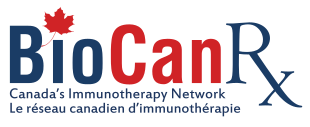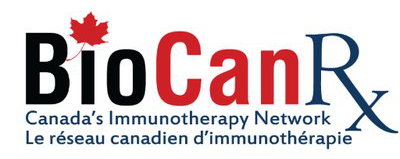The Immune System and Immunotherapy
Reprinted with permission from Patient Resource LLC and the Society for Immunotherapy of Cancer (SITC). Copyright Patient Resource LLC
Antibody – A protein created by B-cells in direct response to specific antigens. An antibody attaches itself to its respective antigen, marking it for other immune cells to “see” and destroy.
Antigen – A protein produced by a cell, virus or bacteria. In the case of cancer antigens, the protein or part of a protein is on the surface of the cancer cell. It alerts the immune system and causes the production of antibodies or the creation of T-cells that can recognize and potentially destroy the cancer cells expressing that antigen.
Antigen-presenting cells (APCs) – Special cells that digest invading cells or soluble (can be dissolved in water) protein antigens and present them to the T-cells and B-cells so they know what to attack.
B-cells – Immune cells that produce antibodies for specific antigens that will bind to the antigens and mark them for destruction by other immune cells.
Biologic product – Medications made from living organisms, such as vaccines, human cells and tissues, and gene therapies.
Biosimilar – A product approved as an alternative to an FDA-approved biologic product based on its similarities and meeting standards for interchangeability, with no clinically meaningful differences between the two. The first FDA-approved biosimilar is filgrastim-sndz (Zarxio), approved in 2015.
Cancer cells – Cells with damaged DNA that causes mutations in normal cell growth and division. New cancer cells grow uncontrollably and old cancer cells don’t die when they should, resulting in a malignant tumor or cancer.
Co-stimulatory signal – The second stimulation required for T-cells to become fully activated (also called Signal 2).
CTLA-4 (cytotoxic T lymphocyte associated antigen 4) – A protein receptor found on the surface of T-cells. This protein is part of the CTLA-4 checkpoint pathway, which can shut down an immune system response in its early stages. Certain cancer cells have the ability to turn on this checkpoint, which stops the immune response against the cancer cells.
Cytokines – Proteins released by immune cells to communicate with other immune cells. Certain cytokines, such as interferon and interleukin, help regulate specific immune system functions.
Dendritic cell (DC) – A type of antigen-presenting cell responsible for processing antigen material and presenting it to the T-cells and B-cells for activation. DCs also are able to help regulate other immune cells.
Downregulation – Reducing either the overall immune system response or the specific responses of certain immune cells.
Granulocyte-macrophage colony stimulating factor (GM-CSF) – A protein responsible for stimulating bone marrow and promoting the growth of immune cells, especially dendritic cells. GM-CSF is currently used to restore white blood cells that have been depleted in people receiving chemotherapy and is being used and studied as a treatment boost when combined with other immunotherapies.
Immune cells – The cells of the immune system involved in defending the body against infectious disease, foreign invaders and cancer cells.
Immune checkpoint inhibitors – Drugs that block the activation of specific immune checkpoint pathways. These drugs allow the immune system to ‘take the brakes off,’ which allows the immune system to recognize and attack cancer cells.
Immune checkpoint pathways – The system of checks and balances in place to prevent overactivation of the immune system. Different pathways function at different stages of the immune response to help regulate the length and intensity of T-cell activity; turning on an immune checkpoint typically results in shutting down the immune system response.
Immunosuppression – A condition in which the immune system is prevented from launching successful attacks to protect the body against infection and disease.
Immunotherapy – A type of cancer treatment that focuses on using the body’s own immune system to fight cancer.
Immune-related adverse events (IRAEs) – Auto- immune reactions that occur as a result of boosting the immune system. Severe reactions may include colitis, dermatitis and hepatitis.
Interferon – A protein released by immune cells that helps regulate different immune cell activity; types of interferon include alpha, beta, gamma and lambda. Different types help regulate different functions, including prompting increased T-cell activity, stimulating natural killer cells or affecting certain cell functions that influence tumor cell growth. Laboratory-made versions of the IFN-alpha protein are currently FDA-approved to treat certain types of cancer.
Interleukin – A protein produced by cells of the immune system that helps regulate the production of certain immune cells, how they function during an immune response and their production of cytokines. The laboratory-made version of this protein, aldesleukin (Proleukin), is currently FDA-approved to treat metastatic melanoma and metastatic renal cell carcinoma (kidney cancer).
Ligands – Protein molecules on the surface of a cell that bind to the receptor on the surface of another cell. Most ligands are signal-triggering molecules, which means they send out immune cell signals when engaged by a receptor. These signals help to regulate specific immune system functions.
Major histocompatibility complex (MHC) – A set of proteins on the surface of certain immune cells that influence the interaction of normal cells with immune cells. Antigen-presenting cells present digested antigens to T-cells through the MHC on their surface, which allows the T-cells to “see” the antigen and recognize it as foreign. The connection between the MHC and the receptor on the T-cell is the first signal (Signal 1) necessary to activate the T-cell to respond to a tumor and destroy it.
Memory cells – T-cells and B-cells from a specific immune reaction that continue to circulate in the body even after the infection is resolved. They “remember” specific antigens and can multiple rapidly upon subsequent exposure, creating an immediate immune response already trained to eliminate the threat.
Monoclonal antibodies (mAbs) – Antibodies made in a laboratory that are designed to target specific parts of cancer cells, which may include certain proteins or molecules on the surface of the cancer cells; they are meant to stimulate an immune response in the same way as naturally produced antibodies do.
Natural killer cells – White blood cells that contain enzymes that kill virally infected cells and tumor cells. They also communicate with T-cells to help regulate their development and response.
Oncolytic virus – A virus that can infect and multiply within cancer cells, leading them to die. These viruses may be manufactured or naturally occurring, and can be used to target and destroy specific tumor cells. They may also induce an immune response.
PD-1 (programmed cell death-1) – The receptor in the PD-1 checkpoint pathway that sends negative signals to the T-cell when it connects to a PD-1 or PD-2 ligand (PD-L1 or PD-L2). These negative signals normally slow down or stop the immune response when it’s no longer necessary. Certain cancer cells have the ability to influence the engagement of this checkpoint, which puts the brakes on the immune response.
Proliferation – Cell division and development (growth).
Receptors (immune receptors) – Proteins on the surface of immune cells that bind to ligands on the surface of other immune cells. This connection typically results in immune cell signaling that regulates specific immune system functions.
Regulatory T-cells – T-cells that help maintain the necessity, strength and duration of an immune response by regulating T-cell activity. They shut down the other T-cells at the end of an immune reaction. Certain tumor cells have the ability to increase regulatory T-cell activity, which decreases the overall immune response.
Signal 1, Signal 2 – The primary and secondary cell signals necessary for the immune system to activate. Signal 1 is the interaction between the antigen-presenting cell and the T-cell through a connection between the major histocompatibility complex (MHC) and a T-cell receptor. Signal 2 can be any number of connections formed by the molecules and receptors on the surfaces of both the antigen-presenting cell and the T-cell.
Standard of care – A treatment regimen that is accepted by medical experts and is widely used as a treatment for a specific type of cancer. This can also be called best practice, standard medical care and standard therapy.
T-cells – Immune cells that recognize specific antigens during antigen presentation. T-cells are the major players in the immune system’s fight against cancer. Their activation and activity are two of the main focuses in immunotherapy research.
T-cell receptors (TCRs) – Molecules found only on the surface of T-cells. TCRs must bind to special molecules on the surface of antigen-presenting cells before they can receive information about a threat. This connection is the first signal (Signal 1) necessary to activate the T-cell to respond to the tumor.
Tumor microenvironment – The area surrounding a tumor, inside which normal cells, molecules and blood vessels help sustain the tumor. The microenvironment contributes to the behavior, proliferation and spread of the tumor; the tumor itself is capable of affecting its own microenvironment.
Upregulate – Increase either the overall immune system response or the specific responses of certain immune cells.
©Patient Resource

